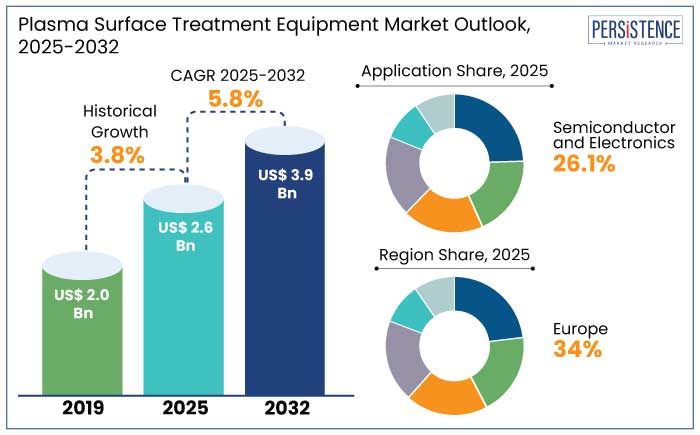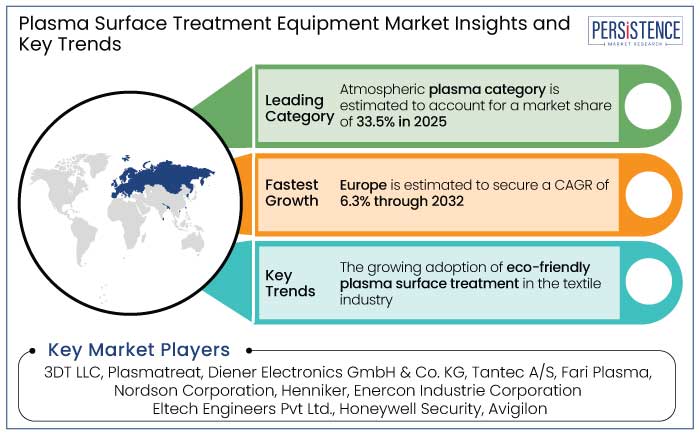Industry: Industrial Automation
Published Date: January-2025
Format: PPT*, PDF, EXCEL
Delivery Timelines: Contact Sales
Number of Pages: 192
Report ID: PMRREP35070
The global Plasma Surface Treatment Equipment Market is projected to witness a CAGR of 5.8% during the forecast period from 2025 to 2032. It is anticipated to increase from US$ 2.6 Bn recorded in 2025 to a US$ 3.9 Bn by 2032.
The plasma surface treatment equipment market is witnessing significant growth due to rapid industrialization and the increasing adoption of plasma surface treatment equipment in the semiconductor and electronics sectors. The global expansion of these sectors has led to a higher demand for plasma surface treatment solutions for applications like surface etching and cleaning. For instance,
Growth in the automotive, aerospace, and semiconductor industries in the U.S. and Canada is driving demand for plasma surface treatment equipment for surface energy enhancement and modification applications. According to a report by PwC, new car sales in the U.S. are projected to rise by 30% between 2024 and 2030, driving market expansion further.

Key Highlights of the Market
|
Market Attributes |
Key Insights |
|
Plasma Surface Treatment Equipment Market Size (2025E) |
US$ 2.6 Bn |
|
Projected Market Value (2032F) |
US$ 3.9 Bn |
|
Global Market Growth Rate (CAGR 2025 to 2032) |
5.8% |
|
Historical Market Growth Rate (CAGR 2019 to 2023) |
3.8% |
Europe is emerging as the notably growing region in the plasma surface treatment equipment market with a share of 34% in 2025. This region is projected to exhibit a CAGR of 6.3% through 2032.
The region is home to a diverse industrial base with strong contributions from the automotive, aerospace, electronics, and medical devices sectors. These industries are increasingly adopting advanced surface treatment technologies to enhance material properties such as adhesion, biocompatibility, and corrosion resistance.
The growing demand for electronic devices, particularly in the automotive and consumer electronics sectors, is accelerating the adoption of plasma treatment technologies across Europe. Moreover, regulatory pressures across Europe are reinforcing the need for high-quality surface treatments.
The European Union’s stringent regulatory framework, particularly in the medical devices, packaging, and electronics industries, necessitates the use of advanced technologies like plasma treatment to ensure compliance with safety and environmental standards. This regulatory environment, coupled with a robust economic landscape and increasing industrial activities, is driving demand for plasma surface treatment technologies.
Countries like Germany, the UK, and France are witnessing significant investments in research and development, further accelerating the adoption of advanced plasma technologies. Consequently, Europe is positioned as the rapidly growing region in the market.
North America is estimated to expand substantially with a CAGR of 5.4% through 2032, driven by the strong presence of well-established industries such as aerospace, electronics, medical devices, and automotive. The region's robust industrial base creates a sustained demand for advanced surface treatment technologies to enhance material properties and meet stringent quality standards.
Notably, the automotive and semiconductor sectors are witnessing remarkable growth, fueling the adoption of plasma treatment equipment. For instance,
The United States, in particular, is expected to observe significant growth due to the rising demand from the automotive, electronics, and semiconductor sectors. These industries rely heavily on high-quality surface treatment technologies to improve adhesion, biocompatibility, and corrosion resistance of materials.
Stringent regulatory frameworks in North America, particularly in sectors such as medical devices and food packaging, necessitate the use of advanced technologies like plasma surface treatment to ensure compliance with safety and quality standards.
The atmospheric plasma segment is anticipated to dominate the plasma surface treatment equipment market with a CAGR of 5.5% through 2032. This market growth is driven by its cost-effective solutions and versatile applications across various industries. In 2023, this segment led the market in revenue, benefiting from its ability to treat a wide range of materials, including polymers, metals, ceramics, and composites.
Key industries such as automotive, electronics, packaging, and textiles increasingly rely on atmospheric plasma for surface activation, cleaning, and coating, boosting its adoption.
The low-pressure/vacuum plasma segment is also expected to witness moderate growth, supported by its growing utilization in emerging applications like biomedical devices, and flexible electronics. Despite its high performance, this technology incurs significant costs due to the requirement of a vacuum chamber for surface modification processes.
The added operational complexity and expense make it a more specialized choice for advanced applications. However, these capabilities contribute positively to the overall growth of the pressure vacuum plasma segment, reflecting its critical role in niche markets.
Based on application, the semiconductor and electronics segment is projected to exhibit a CAGR of 5.6% through 2032. The semiconductor and electronics sector dominates market with a share of 26.1% in 2025. This dominance is attributed to the rising demand for printed circuit boards (PCBs), integrated circuits (ICs), and semiconductor chips.
Plasma surface treatment systems play a critical role in this sector, being extensively used for applications such as cleaning, etching, deposition, surface modification, and improving component reliability. These capabilities are essential for ensuring high performance and durability in semiconductor and electronic devices, thereby driving plasma surface treatment equipment market growth.
The manufacturing and fabrication segment, particularly for metals and conductive materials, is also projected to grow steadily due to increasing demand from the electronics industry. Plasma surface treatment equipment in this segment is utilized for processes like etching, surface modification, and cleaning, which are pivotal for enhancing the quality and functionality of electronic components.
The plasma surface treatment equipment market is experiencing notable growth, driven by its expanding applications across industries and increasing demand for sustainable solutions. A key trend propelling market expansion is the rising adoption of eco-friendly plasma surface treatment within the textile industry.
Surface modification techniques are gaining traction globally as manufacturers prioritize enhancing product quality while adhering to environmentally sustainable production practices.
Plasma treatment, known for its versatility across a wide range of temperatures and pressures, offers a superior solution for achieving unique surface properties in textiles. This includes improved printability, dyeability, hydrophobicity, adhesion, color fastness, and efficient dirt removal. By enabling these advanced finishes under environment-friendly conditions, plasma surface treatment is becoming an essential technology in the textile sector. This trend reflects broader market advancements and underscores the pivotal role of plasma technology in driving innovation and sustainability in modern manufacturing.

The global plasma surface treatment equipment market exhibited a moderate CAGR of 3.8% during the period from 2019 to 2023. The COVID-19 pandemic had a mixed impact on the industry, causing disruptions in raw material supply chains and reducing demand from sectors such as aerospace, automotive, and electronics, temporarily hindering market growth.
The pandemic underscored the increasing adoption of plasma treatment technologies in the medical and healthcare sectors, as well as heightened activity in the packaging industry. Rising investments in research and development during and post-pandemic have also supported the market growth.
The market is projected to expand at a CAGR of 5.8% during the forecast period from 2025 to 2032. This growth is driven by strong demand across diverse industries and continuous technological advancements, positioning the market for steady expansion in the forecasted period.
Rising Adoption of Plasma Devices in the Semiconductor and Electronics Sector
The increasing adoption of plasma processing technologies in the semiconductor and electronics sector is emerging as a significant driver for the plasma surface treatment equipment market. Plasma devices play a crucial role in ensuring clean surfaces and precise patterning, which are vital for the reliability and performance of semiconductor components.
By effectively addressing challenges such as Non-Stick on Pad (NSOP) issues and removing oxide layers, plasma enhances the efficiency and dependability of semiconductor devices. These technologies are extensively used in critical manufacturing processes, including etching, cleaning, and deposition, which are essential for the production of integrated circuits, consumer electronics, automotive electronics
As the demand for the advanced applications grows, manufacturers are increasingly relying on plasma processing to meet the precision and quality requirements of the industry. Leading companies are investing in innovative plasma solutions to remain competitive. For example,
Increasing reliance on plasma technology is expected to have a positive impact on the market, driven by the increasing demand for high-performance electronics and the need for efficient manufacturing processes in the semiconductor industry.
High Initial Capital Investment Remains a Key Barrier
The growth of the plasma surface treatment systems market is significantly hindered by the high capital investment required for these advanced technologies. Acquiring and installing plasma surface treatment equipment often demands a substantial upfront expenditure, typically ranging from USD 5,000 to USD 8,000 per unit. This cost poses a considerable barrier for small and medium-sized enterprises (SMEs) and businesses operating with limited budgets.
The long-term financial burden does not end with the initial purchase. Ongoing maintenance costs, including regular servicing, calibration, and replacement of consumable components, add to the total cost of ownership, further deterring potential buyers.
For many companies, especially those in price-sensitive markets, uncertainty about achieving a sufficient return on investment (ROI) makes adopting plasma surface treatment systems a challenging proposition.
The complex nature of plasma technologies often necessitates skilled personnel for operation and maintenance, contributing to higher operational expenses. These financial and operational constraints collectively restrict market adoption, particularly in emerging economies and industries with limited capital resources.
The Automotive and Electronics Industry to Provide Growth Opportunities
The automotive and electronics industries offer substantial opportunities for manufacturers and suppliers of plasma surface treatment equipment. Global automobile production grew from 80 million units in 2021 to 85 million units in 2022, and further surged to 94 million units in 2023, reflecting a 10% year-on-year increase.
Sales followed a similar trend, rebounding from 83 million units in 2022 to 93 million units in 2023, with annual production and sales expected to surpass 100 million vehicles soon. This rapid growth, coupled with the increasing use of lightweight and composite materials such as thermoplastics and carbon fiber, creates demand for advanced surface treatment solutions.
Plasma surface treatment effectively addresses adhesion and coating challenges, enabling durable bonds for paints, adhesives, and coatings. With the market for plasma surface treatment equipment projected to expand at a CAGR of approximate 6% by 2030, manufacturers and suppliers have a prime opportunity to expand their offerings and meet industry needs.
Growing Adoption of Eco-friendly Plasma Surface Treatment to Open the Door for Opportunities
The plasma surface treatment equipment market is experiencing significant growth, driven by its expanding applications across industries and increasing demand for sustainable solutions. A key trend propelling market expansion is the rising adoption of eco-friendly plasma surface treatment within the textile industry.
Surface modification techniques are gaining traction globally as manufacturers prioritize enhancing product quality while adhering to environmentally sustainable production practices.
Plasma treatment, known for its versatility across a wide range of temperatures and pressures, offers a superior solution for achieving unique surface properties in textiles. This includes improved printability, dyeability, hydrophobicity, adhesion, color fastness, and efficient dirt removal.
By enabling these advanced finishes under environmentally friendly conditions, plasma surface treatment is becoming an essential technology in the textile sector. This trend reflects broader market advancements and underscores the pivotal role of plasma technology in driving innovation and sustainability in modern manufacturing.
The global plasma surface treatment equipment market is characterized by intense competition, with leading players adopting strategic initiatives such as product launches, acquisitions, collaborations, and business expansions to solidify their positions. Prominent market participants include 3DT LLC, Pink GmbH Thermosysteme, Plasmatreat, Diener Electronics GmbH & Co. KG, Tantec A/S, and others.
Leading companies are focusing on innovation, operational expansion, and partnerships to address the growing demand for advanced surface treatment technologies across diverse industries. For instance,
Recent Industry Developments
|
Attributes |
Details |
|
Forecast Period |
2025 to 2032 |
|
Historical Data Available for |
2019 to 2023 |
|
Market Analysis |
US$ Billion for Value |
|
Key Regions Covered |
|
|
Key Market Segments Covered |
|
|
Key Companies Profiled in the Report |
|
|
Report Coverage |
|
|
Customization & Pricing |
Available upon request |
By Product Type
By Application
By Region
To know more about delivery timeline for this report Contact Sales

Yes, the market is set to reach US$ 3.9 Bn by 2032.
Semiconductor & electronics are the main consumers that companies need to target.
Europe is estimated to witness a high market share in 2032.
Some of the leading key players in the market are 3DT LLC, Plasmatreat, and Diener Electronics GmbH & Co. KG.
Growing adoption of eco-friendly plasma surface treatment presents a key opportunity for market players.